Calibration refers to the process of monitoring and standardizing between different quality monitors. The purpose of calibration is to ensure consistency and fairness in evaluating the performance of call center agents.
How is calibration performed?
1. Selection of contact for calibration:
To start the calibration process, a person from the team responsible for quality monitoring will select a specific contact that will be used as a reference. This contact can be chosen at random or based on pre-defined criteria, as a representative example of the interaction between operators and customers.
2. Expert choice:
After selecting the contact, the person in charge of the calibration must decide which specialist will be responsible for evaluating this interaction. The specialist is usually someone with extensive knowledge and experience in the field, who has skills to analyze and correctly score the quality aspects involved in customer service.

3. Definition of participants:
During the calibration process, it is important to involve other people from the quality monitoring team. The selection of participants can vary, but generally includes monitors responsible for the daily evaluation of the calls. This diversity of participants is critical to gaining a comprehensive perspective on the quality of care.
4. Comparison of deviations:
After the evaluations are carried out by the monitors, it is necessary to compare the deviations in relation to the scores assigned by the specialist. This comparison is important to identify discrepancies and adjust possible differences in perception and evaluation criteria between monitors. It is common for variations in the assigned scores to occur, and the objective is to reduce these differences as much as possible to ensure a more uniform and accurate evaluation.
By comparing the deviations, the monitors have the opportunity to analyze the differences in their evaluations in relation to the expert. This allows the identification of points for improvement, adjustments in the evaluation criteria and the sharing of good practices among the team.
In short, calibration in quality monitoring in call centers is a process that aims to ensure the consistency and accuracy of the evaluations carried out by the monitors. Through the selection of a contact for calibration, the choice of an expert, the participation of several monitors and the comparison of deviations, it is possible to obtain a more aligned evaluation and provide fairer and more effective feedback to call center operators. This contributes to improving the quality of customer service and the overall performance of the
Team.
Which contact should be chosen in calibration?
When performing calibration in quality monitoring in call centers, the proper selection of the contact used as a reference is essential to ensure an efficient and comprehensive process. See the main factors:
Contacts with disputes from attendants
A valid option is to choose contacts in which the agents themselves have disputed the evaluation. These cases provide an opportunity for discussion and alignment between monitors in order to understand different perspectives and ensure a more accurate evaluation.
More difficult contacts
Opting for contacts that present greater complexity or challenge is also a valid approach to calibration. These interactions can involve dissatisfied customers, complaints situations or complicated demands. By evaluating these contacts jointly, monitors can align their perceptions and improve the evaluation in these more difficult cases.
Contacts that present non-standard situations
Selecting contacts that deviate from the common standard of care can be useful for calibration. These unusual situations may involve outliers such as complex technical issues, unusual demands or special requests. By analyzing and scoring these contacts together, monitors can align their evaluations and develop consistent criteria for dealing with out-of-the-ordinary scenarios.
Contacts that allow evaluating all items on the form
It is important to choose contacts that address all items and criteria present in the evaluation form. In this way, it is possible to guarantee a comprehensive calibration, in which all relevant aspects of the service are covered. This contributes to a more complete and accurate evaluation of operators’ performance.
Contacts with grades outside the quality average
Including contacts who received significantly high or low ratings in previous evaluations can be helpful for calibration. These interactions allow for a more detailed analysis of the reasons behind extreme scores and help identify discrepancies or inconsistencies in the monitors’ evaluations.
Contacts for new products or services:
When introducing new products or services, it is important to select contacts related to these new products for calibration. These interactions allow assessing the understanding and correct handling of information about newly launched products or services. In addition, they provide an opportunity for monitors to become familiar with the particularities of these novelties and align their evaluations.
How to choose the specialist for calibration?
The choice of specialist plays a crucial role in ensuring the efficiency and consistency of the process. When selecting the professional responsible for this function, it is necessary to consider some essential qualities and attributions. Below are the main points about what the specialist will need:
Facilitate calibration sessions
The specialist must have facilitation skills to conduct calibration sessions effectively. This includes establishing a collaborative and respectful environment, promoting the active participation of all involved. The specialist must ensure that the discussions are focused on the relevant aspects of the evaluation and that there is space for exchanging ideas and clarifying doubts.

Provide guidance and clarification
It is the specialist’s responsibility to provide clear guidance to monitors during calibration sessions. It should clarify the evaluation criteria, explain the key points to be considered and help the participants to understand the established quality standards. The specialist should also offer constructive feedback and suggestions for improvement, promoting the continuous development of the monitors.
Document calibration results
The specialist must be diligent in documenting the results and conclusions reached during the calibration sessions. These records are critical for tracking progress over time, identifying trends, and assisting in the review and review process. In addition, the documentation allows a consistent and reliable reference for future calibrations and quality monitoring program enhancements.
Generate consistency in evaluations
One of the specialist’s main objectives is to ensure consistency in the evaluations carried out by the monitors. This involves defining clear guidelines and evaluation criteria in order to minimize subjectivity and discrepancies in scores. The expert should share concrete examples, provide case studies and work closely with monitors to achieve a common understanding and consistent approach to evaluation.
In addition to the duties mentioned above, the specialist chosen for quality monitoring calibration in call centers must have the following skills:
Experience in monitoring
It is essential that the specialist has previous experience in quality monitoring. This experience provides practical knowledge about the challenges and nuances of the evaluation process, as well as familiarity with the specific aspects of customer service in a call center. The experience in monitoring also allows the specialist to have a deeper understanding of the performance metrics and established quality standards.
Strong understanding of the evaluation criteria and standards:
The specialist must have a solid knowledge of the criteria and evaluation standards used in quality monitoring. He must be thoroughly familiar with the guidelines set by the company and be able to explain and apply these criteria consistently. A thorough understanding of evaluation standards allows the specialist to provide accurate and informed guidance to monitors during calibration sessions.
Good communication
Communication skills are essential for the calibration specialist. He must be able to clearly convey expectations, provide constructive feedback and facilitate effective discussions during sessions. In addition, the expert must be able to actively listen to participants’ opinions and perspectives and articulate their own ideas in a clear and understandable way. Effective communication is essential to promote alignment and mutual understanding between the specialist and the monitors.
Ability to encourage discussion in calibration sessions:
The expert must be able to encourage and moderate productive discussions during calibration sessions. It should create an enabling environment for monitors to express their opinions, debate different points of view and share their experiences. The specialist should encourage the active participation of all those involved, promoting a constructive dialogue that leads to the alignment of evaluations.

Which monitors should participate in the calibration?
It is of utmost importance that all monitors evaluating the same product or service actively participate in the calibration sessions, rather than just some of them.
By involving all monitors, it is possible to align individual perceptions, clarify doubts and promote a shared understanding of the evaluation criteria. In addition, the participation of all monitors increases the representativeness and diversity of perspectives, resulting in a more comprehensive and impartial evaluation. The collaboration of the entire team of monitors in calibration contributes to a more accurate, fair and reliable evaluation, providing consistent feedback and helping to continuously improve customer service.
Should supervisors participate?
While it is essential that all monitors participate in calibration sessions, it is advisable to carry out dedicated calibrations exclusively for supervisors.
These sessions provide the opportunity to further deepen understanding of the evaluation criteria and provide specific guidance for supervisors who play a crucial role in leading and supporting the care team. In addition, the dedicated calibration for supervisors allows for the exchange of best practices, deeper discussions on the challenges faced and the sharing of effective coaching strategies. This approach helps to strengthen supervisory skills and, consequently, the quality of evaluations carried out by the entire team. Therefore, a dedicated calibration for supervisors can be a valuable resource to improve overall call center performance.
Let’s go to a calibration example
During a calibration session, monitoring team members gather to review and discuss a set of recorded customer interactions, such as phone calls or chats…
They aim to reach consensus on how to evaluate and score these interactions based on predefined criteria.
For example, let’s consider a specific criterion like “Adherence to scripts”.
Each evaluator independently assesses the interaction and assigns a score based on their understanding of adherence to the scripts.
After everyone has rated the interaction, they compare their scores with the expert and discuss any discrepancies.
Suppose an evaluator scored the agent low because he felt the agent deviated from the script too often, while the expert scored higher, considering the agent’s deviations as personalized touches to provide better customer service. In this scenario, raters would discuss their perspectives, share insights, and try to reach consensus on how to consistently assess adherence to roadmaps.
How often should I perform calibration?
The periodicity of calibration in quality monitoring in call centers can vary depending on different factors. It is crucial to consider the following points when determining the appropriate frequency for calibration sessions:
call center size
The size of the call center plays an important role in the frequency of calibration. Larger call centers with many operators and evaluations to perform may require more frequent calibrations to ensure consistency and quality of evaluations.
Complexity of care
If calls in the call center are particularly complex, involving challenging situations or specialized needs, it may be necessary to perform calibrations more frequently. This will allow assessors to fine-tune their evaluation skills to deal with these complex situations consistently.
Evaluators’ experience level
The evaluators’ experience can also influence the frequency of calibration. More experienced assessors with greater evaluation skills may not need calibration sessions as frequently as those who are just starting out. However, it is important to ensure that all raters are calibrated regularly to maintain consistency.
Frequency of changing evaluation criteria
If evaluation criteria are updated or modified frequently, it is essential to perform more frequent calibrations to ensure that all assessors are aligned with the changes. This will help maintain consistency in evaluations and ensure operators are assessed against updated standards.
We suggest that the maximum period to perform a calibration is quarterly, ensuring that it occurs at least every three months. However, depending on the factors mentioned above, it may be necessary to perform calibrations more frequently, such as monthly or even weekly, to ensure that evaluations are consistent, accurate and in line with business expectations.
What are the benefits?
Through open discussions and sharing of views, the evaluators would work together to establish a common understanding and reach agreement on how to assess adherence to the roadmaps uniformly across the team. This process helps eliminate inconsistencies and ensures that all agents are evaluated fairly against agreed standards.
By conducting regular calibration sessions, monitoring staff can maintain consistency in their evaluations and ensure that all agents are assessed using the same criteria. Ultimately, this leads to a more accurate and fair evaluation of agent performance, allowing the call center to identify areas for improvement and provide targeted training and coaching to agents.
Why calibrate in CYF Quality?
We have improved the CYF Quality calibration process in order to optimize and streamline the activities mentioned in this content even more.
Know the benefits:
1. Online and flexible evaluation
With CYF Quality, each monitor can carry out their evaluations at their own time and online, without the need to interrupt work and move to a specific location. This provides greater flexibility and convenience, allowing monitors to complete evaluations according to their availability, optimizing the use of working time.
2. Elimination of wasted time
When the team is already well aligned and there is no need to discuss the evaluations extensively, CYF Quality avoids wasting time. Instead of pulling all monitors together for face-to-face calibrations that may become unnecessary, CYF allows staff to focus on their regular activities while maintaining operational efficiency.
3. Automatic report of deviations
One of the main advantages of CYF Quality is the automatic generation of deviation reports. Based on the evaluations carried out by the monitors, the software compiles the data and identifies discrepancies in relation to the specialist. This report provides valuable insights into individual and collective performance, allowing the team to take corrective action quickly and effectively.
In addition to these benefits, CYF Quality offers additional features such as review history, improvement tracking, and trend analysis over time.
See how to do Calibration in CYF Quality step-by-step
Next, I present a step by step on how to start a calibration process in the CYF Quality software:
1. Enter or choose an existing contact:
On the CYF Quality home screen, locate the service channel that will be used for calibration. Enter a new contact or select an existing one from the options within the service channel:
- To search for
In this option you can fill in filters to search for the desired contact.
- list all
In this option it will bring the last contacts inserted.
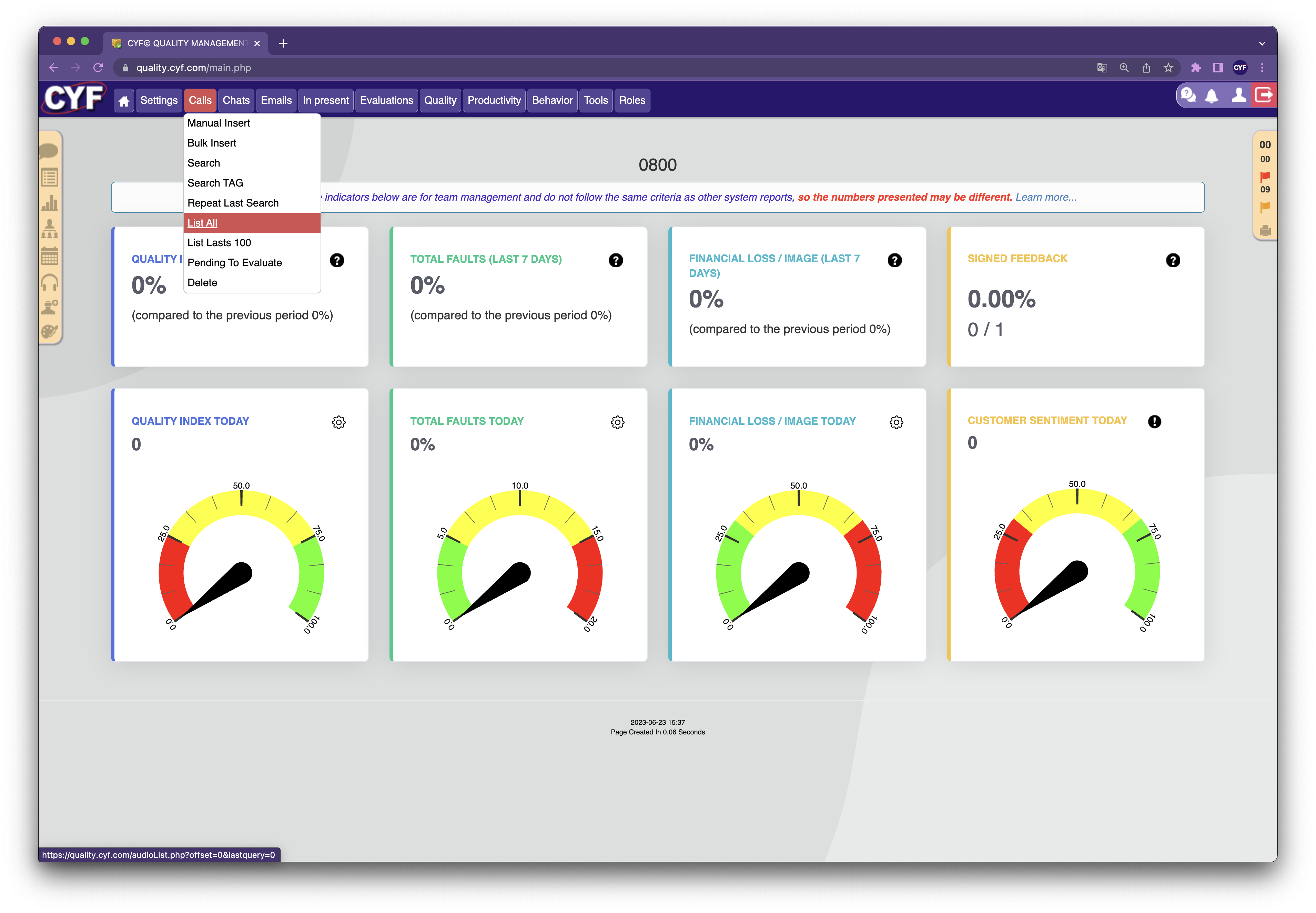
2. Click on the “Start Calibration Process” icon:
Once the desired contact has been selected, click on the icon to start the calibration process.
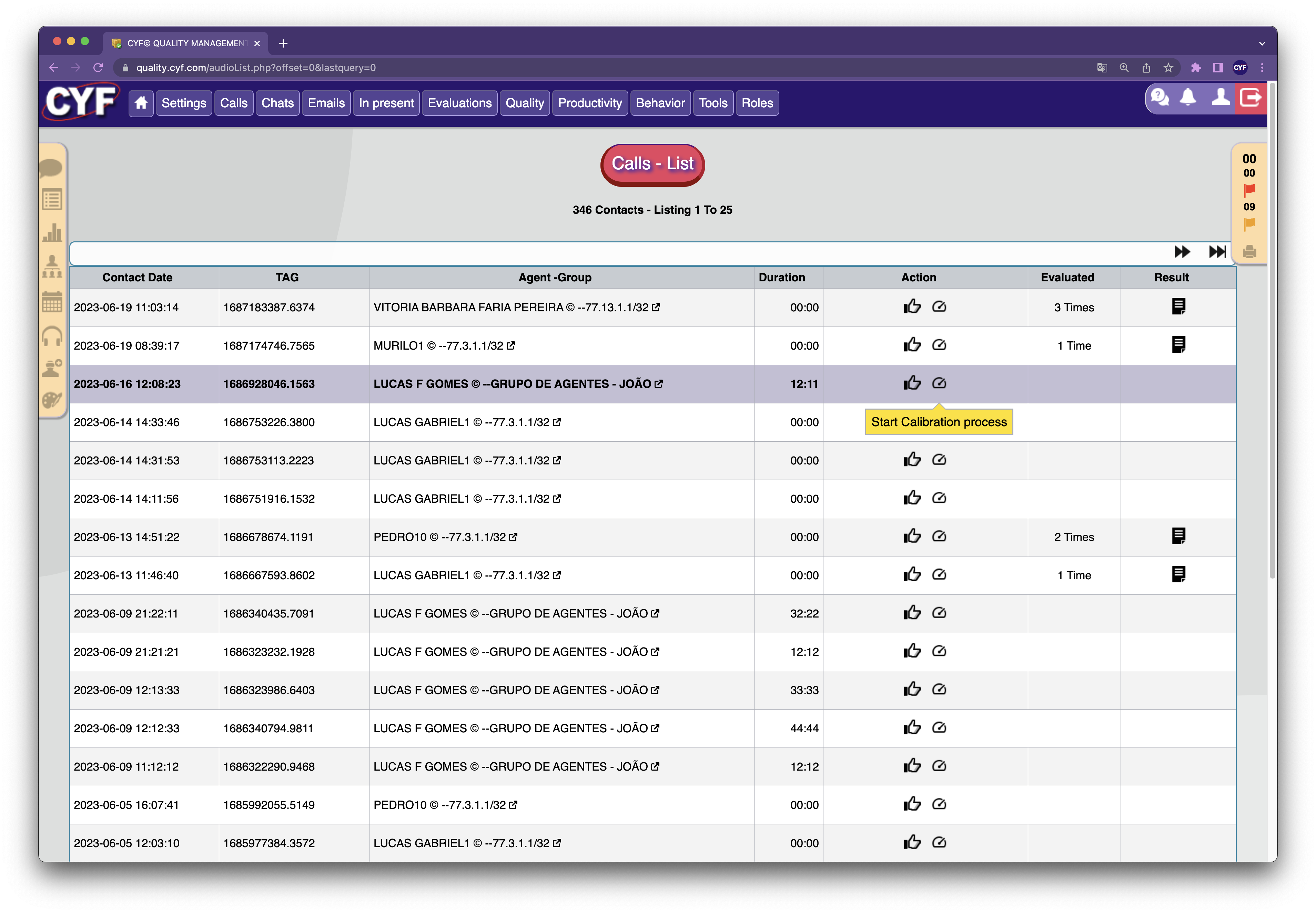
3. Choose the desired form:
After starting the calibration process, you will be directed to a page where you can choose the specific form that will be used for evaluation. Select the appropriate form that best fits the needs of the calibration process.
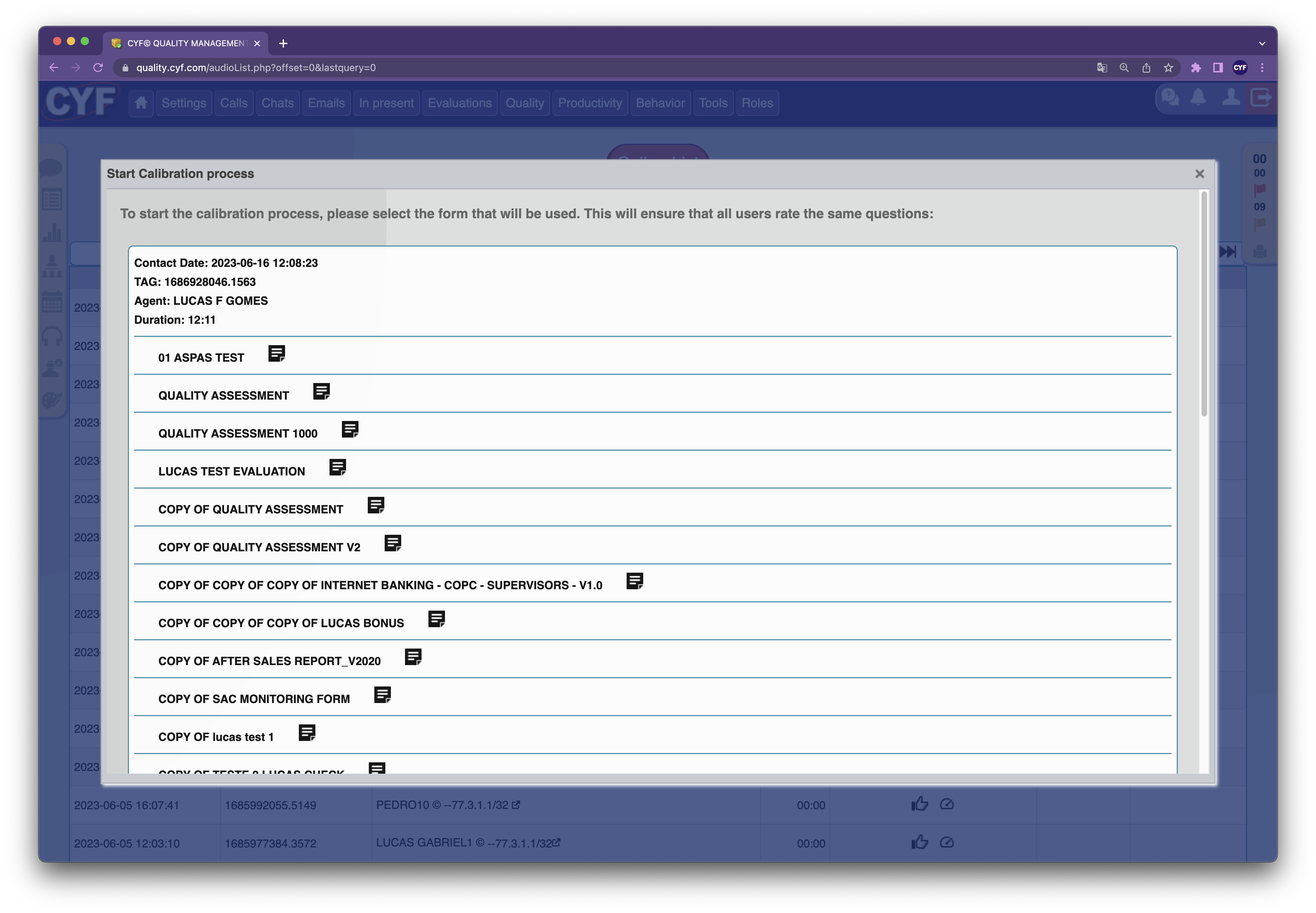
4. Fill in essential calibration information:
In this step, you will need to provide essential information for the calibration. Fill in the deadline to perform the calibration, defining a deadline for completing the process. Also, provide a meaningful name for the calibration process that clearly and uniquely identifies it.
5. Define the participants:
Now it is necessary to define the participants of the calibration process. Select the specialist responsible for conducting the calibration and performing the evaluations. In addition, you can add other users who will also participate in the process, such as other monitors or supervisors.
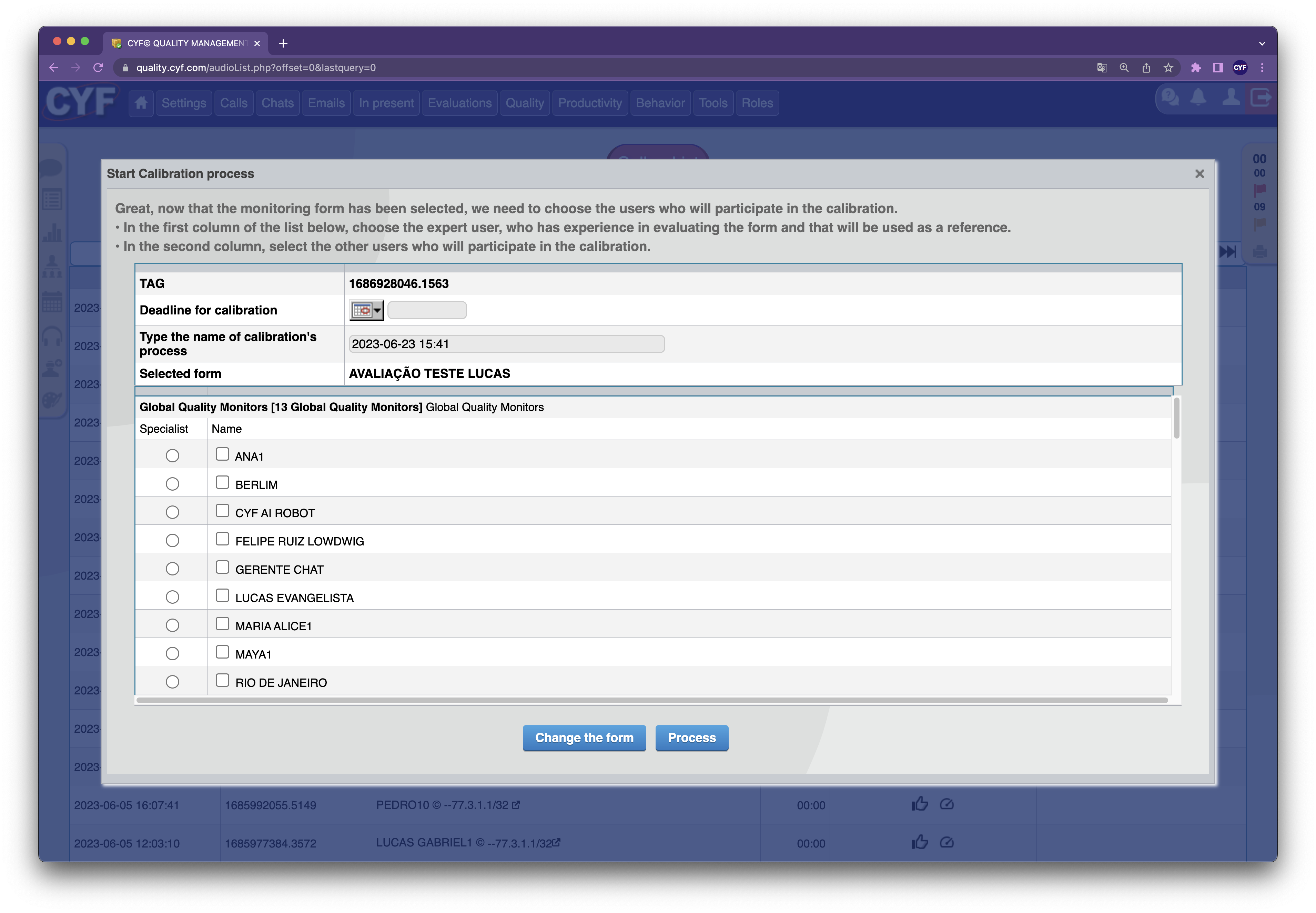
6. Complete the process:
After filling in all the information and defining the participants, complete the calibration process. Check that all information is correct and confirm the creation of the calibration process in Cyf Quality.
Once this is done, remember the following points:
- The calibration will be available in the service channel in the sub-menu ‘Pending to evaluate’.
- Calibration participants will be notified via email and when they access CYF Quality.
- Results will only be visible after all participants have completed their monitoring or when the deadline has passed.
7. Follow the results through the reports:
Once the calibration process is completed, you will be able to follow the results through the reports generated by CYF Quality. These reports will provide detailed information on identified deviations, scores assigned by assessors, and other relevant metrics. Use these reports to analyze and take appropriate action to
improve the quality of care.
Averages
The first view you have is the overall grade average and the average time taken for the evaluation of all participants.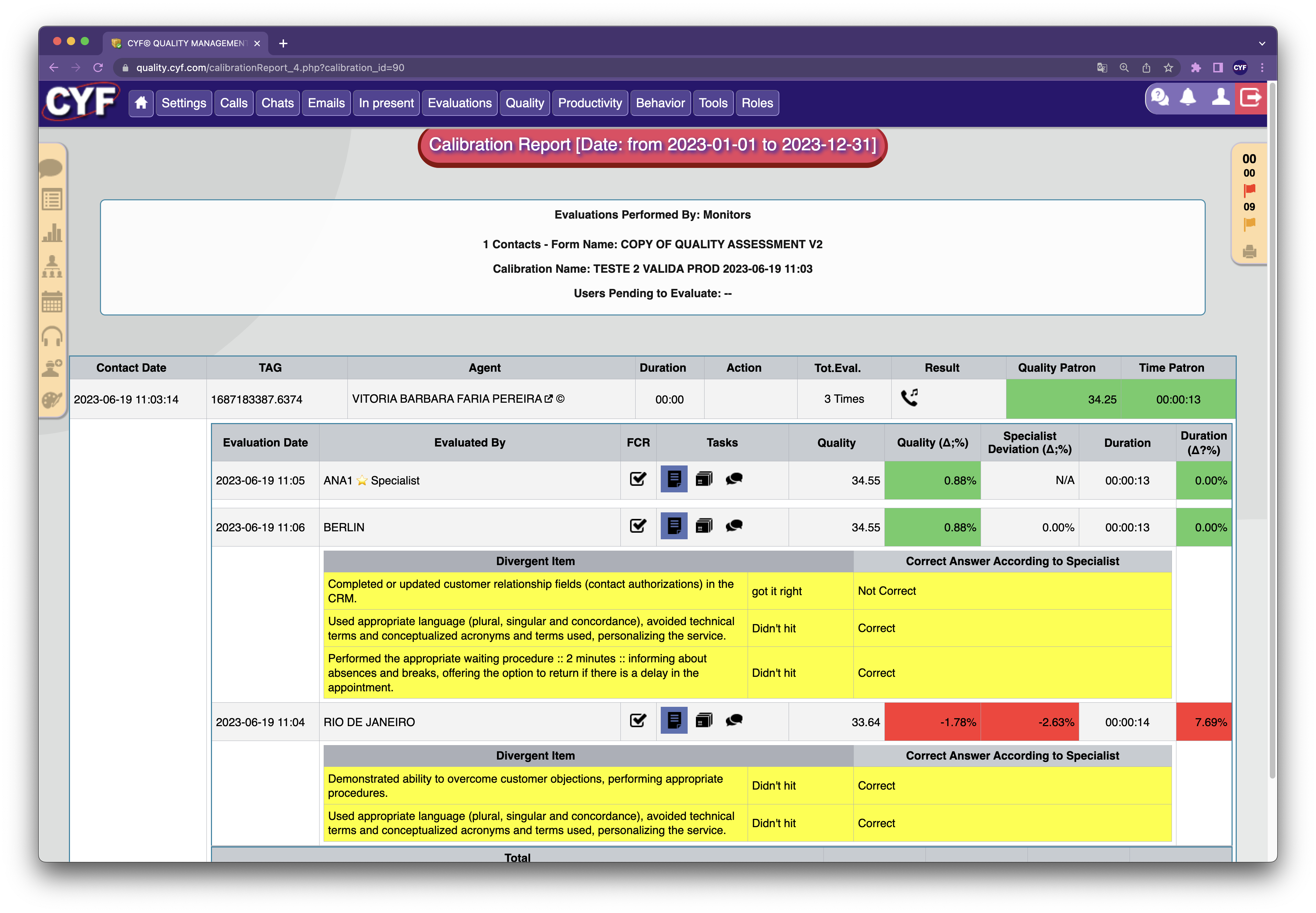
Columns
See that below the averages, you have access to views of all participants, let’s understand the columns:
- Quality
See the grade that each evaluator applied to the contact.
- Quality (Δ,%)
See the deviation of all reviewers from the overall average of reviews.
- Expert Deviation (Δ,%)
Understand the score deviation of the evaluators compared to the expert.
- Duration
See the time spent by each evaluator to perform the calibration.
- Duration (Δ,%)
Compare each rater’s duration to the average of all raters.
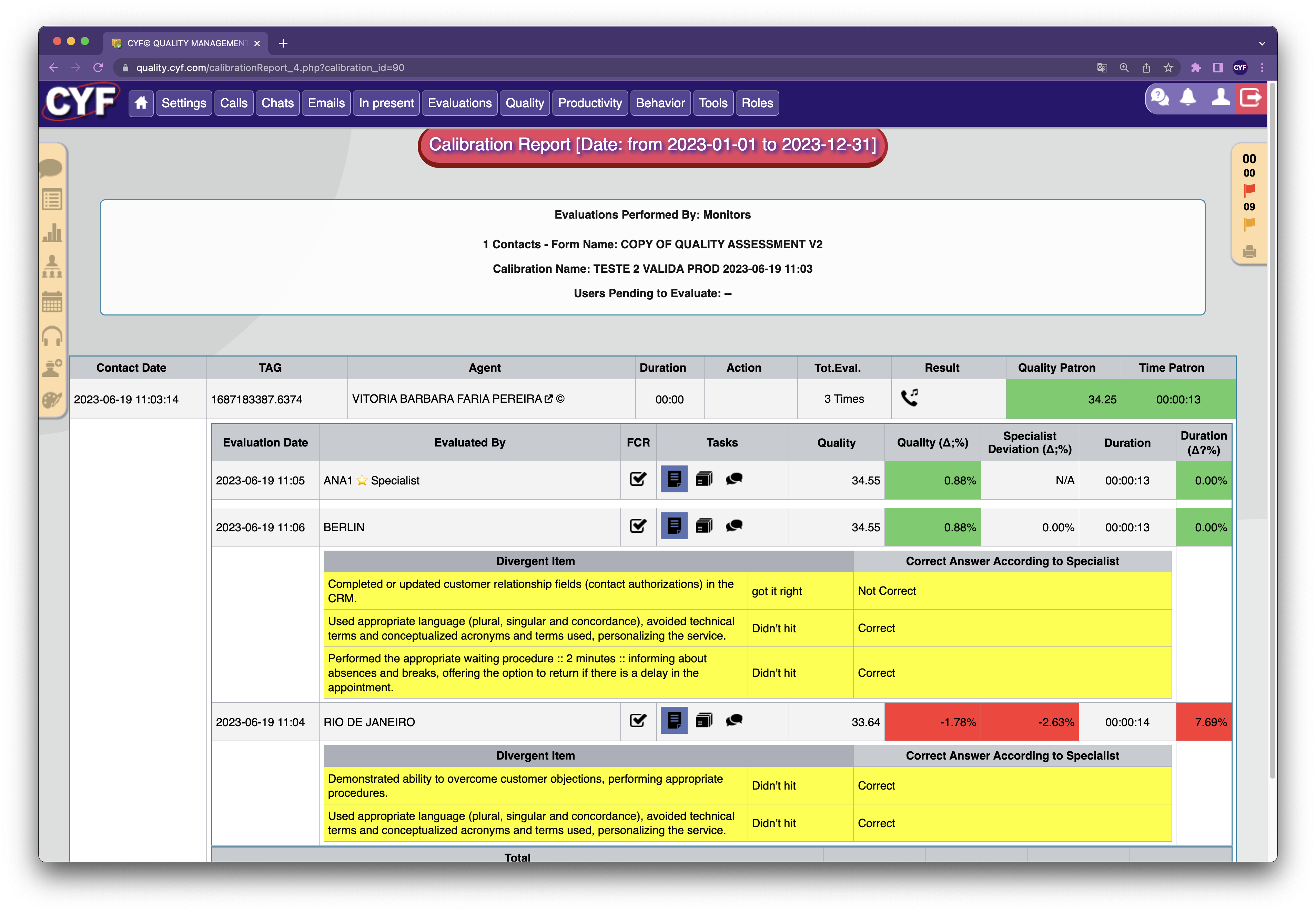
Conclusion
Calibration in quality monitoring is an essential process to ensure consistency, accuracy and fairness in agent evaluations.
Through careful selection of contacts used as a reference, involvement of an experienced specialist, participation of the entire team of monitors, comparison of deviations and constructive discussions, it is possible to obtain a more aligned evaluation and provide effective feedback to operators.
Calibration should be performed on a regular basis to track progress, identify trends and promote continued development of the quality monitoring program. By investing in this process, call centers can achieve a higher level of excellence and customer satisfaction.
